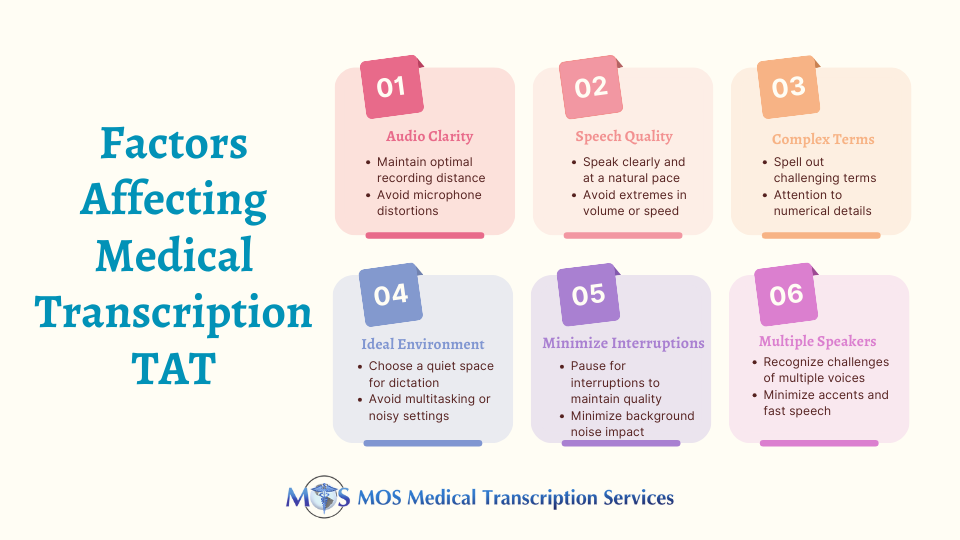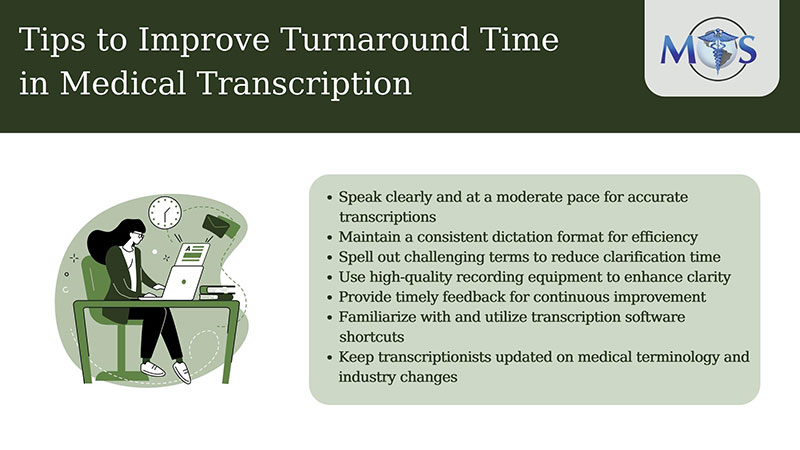
Table of Contents
Medical transcription plays a crucial role in helping physicians accurately document patient information and maintain good healthcare records. Having the transcription task handled by experts can ensure high-quality, timely documentation. Turnaround time is one of the key considerations when choosing a medical transcription company.
What is Turnaround Time (TAT) in Medical Transcription?
Turnaround time refers to the window of time between the dictation of a report and when it is transcribed and returned to the client. Timely and accurate healthcare documentation facilitates continuity of care for the patient by ensuring that all providers involved in the patient’s care have the same information to help them make the best clinical decisions quickly. However, several factors can impact the turnaround time of medical transcription services.

Factors Impacting TAT and How to Minimize their Impact
From a dictation and transcription standpoint, the ideal scenario would be one in which your transcribed reports are available immediately or as quickly as possible regardless of any contracted and defined guidelines or TATs otherwise specified. However, many factors influence TAT and as a physician, you need to be aware of them when they send out your dictation for transcription.
- Audio recording clarity: A good quality recording is essential for high quality medical transcription. If you are too close to the microphone, it could add plosives to your audio and make it harder for the transcriptionist to understand your speech. They would have to rewind the audio to catch the words, losing time and increasing TAT.Best practice is to hold your telephone, recorder or smartphone at the same distance from your mouth as you would when talking on the phone. Keep some distance from the device of recording equipment you’re using. Most devices will recommend the optimal distance in their manual, but you may need to experiment and find out what works best.
- Speech clarity: Speaking softly, very quickly or very loudly can distort the audio. Mumbling when repeating the same procedure multiple times a day is a common challenge for medical transcriptionists. Fatigue can also alter speech patterns, leading to whispers or less clear dictation. The solution: speak clearly and at a natural pace.
- Complex words: Transcriptionists may have difficulty recognizing unfamiliar words. If words cannot be transcribed, transcriptionists will leave blanks in the transcript. Documents that are incomplete will require more time to transcribe and cost more. Reliable transcriptionists refer to Steadman’s Medical Dictionary and other resources to verify spellings, highly technical medical terminologies, medical jargon, slang etc. Such research takes time. Even experienced medical transcriptionists can take a longer time to transcribe a small file with complex words.Spell out names and medical terminologies that are difficult to understand. Likewise, pay special attention to numerical descriptions and units of measure.
- Environment: Physicians don’t always dictate in ideal conditions. They often multitask, dictating while eating, chewing gum, driving, or in noisy surroundings like crowded rooms or hospitals. This can impact the quality of their dictation recordings due to background noise and distractions.As far as possible, ensure you’re dictating in a quiet place without a lot of background noise. Avoid places like corridors when dictating as it can cause an echo and affect the audio. Avoid eating while dictating.
- Interruptions:Engaging in a conversation while dictating will impact the recording. Interruptions happen, but make sure they don’t affect dictation quality. If an interruption occurs or you want to converse, pause the audio and resume when you’ve finished. Some systems may require you to start a new file if you hit Pause.
- Multiple speakers: Doctors’ visits can have multiple speakers. Audio recordings with one or two speakers are easy to transcribe, but when there are multiple voice, the transcriptionist may find it difficult to identify each speaker. Heavy accents and speaking too fast can also cause problems. These factors can increase transcription time.
Technology can address this concern. For example, Google’s Cloud speech-to-text tool is specially designed to recognize multiple speakers in the same audio clip. Words spoken by each person such as the physician, nurse and patient, are automatically detected by the medical model for conversations and labeled in the automated transcript. Using this option can improve transcription outcomes.
- Proofreading requirements: If medical transcripts contain errors, it can compromise patient safety, even with serious consequences. Leading medical transcription companies put all transcripts through a multi-tier quality check to ensure the highest level of accuracy. Regardless of the technique used, proofreading is an important consideration when it comes to TAT.
In addition to transcription anomalies, the AHIMA-MTIA joint task force’s survey identified other factors contributing to TAT noncompliance in 2008 as staffing, work volume changes, new technology and equipment installation and TAT expectation changes.
Over the years, advancements in technology and changes in regulations and reimbursements impacted TAT for different document types.
Having a good idea about the factors that influence TAT can help you address them and get the most out of your medical transcription service.

Customized Turnaround Times Prevent Backlog
Partnering with a professional medical transcription company will ensure that your medical reports are duly transcribed within the specified TAT. This can ease any chance of a backlog that needs to be tackled and also reduces the chance of data being lost. They can provide customized solutions to ensure that all reports, notes and summaries related to a particular case are well-organized, making reference easier.


